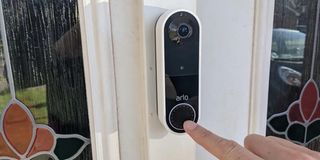Make life easier with a wireless doorbell

Wireless door bells are more affordable since installation does not require any wiring. PHOTO/unsplash.com
What you need to know:
Installing doorbells does not require drilling holes in the doors or walls, it also does not involve laying long wires all over the property
New innovative technological products are launched every day that make modern living manageable. One of these products is a wireless doorbell.
If you have been in a situation where, you were stuck outside your gate because those in the house could not hear you knock, and you could not call them either because of some unfortunate reason, then this doorbell might be such a life saver for you. Back in the day, doorbells were found only in wealthy people’s residences and they were quite pricy to install. Today, however, with the advent of wireless doorbells, they are much more affordable and accessible to the common man.
How wireless doorbells work
Wireless doorbells function exactly as the wired ones, the difference is the installation process. Unlike wired doorbells, wireless doorbells do not require any wires for installation and they can be installed anywhere.
Wireless doorbells have changed over time, with new features being added to them every other time, however, a conventional/classic wireless doorbell is made up of interconnected devices, the push button, which is put outside your the house at the door or gate, and the sounder/ receiver which is plugged into a socket in the house. So when someone at the door presses the doorbell outside, the sounder/receiver inside will ring, letting you know that someone is at the door.
The sounder should be plugged into a socket, for it to ring, most sounders have different ring tones to choose from, and you can adjust the volume as well. The doorbell push button outside is powered either by replaceable batteries or by an in-built rechargeable battery, so there is no need to worry when power is off.
Installation
Installing wireless doorbells does not require drilling holes in the doors or walls. It also does not involve laying long wires all over the property. The doorbell is mounted, by screwing or sticking it onto the door or wall, you can do it yourself.
According to Lutaaya Patrick Mwesigwa, the technical manager at Sekanyolya Systems Limited, the doorbell push button and sounder, use short radio waves to communicate, which is why the distance between the two should not be more than 50 metres.
The sounder/receiver should be plugged into a socket close to the doorbell outside. For this reason, wireless doorbells are more suitable for apartments and small houses.
Types
Audio intercom wireless bell
These have an audio intercom, which enables the homeowner, to speak to the person at the door through the audio intercom installed in the doorbell.
“With this doorbell, your phone is what works as the receiver, so when someone pushes the ring button outside, you will receive a notification on your phone, and then through an app on the phone, you can talk to the person at the door,” Lutaaya explains. Audio intercoms are a bit more expensive than classic doorbell, whose job is only to ring.
Video intercom wireless bell
With a video intercom, you can speak and see the person at the door outside. Just as the audio intercom, your phone will ring, or you will receive a ringing notification on your phone. Then through the app on the phone, you will be able to see and speak to the person at the door before you can open it.
Video intercoms, also help you keep a tab on the activities going on outside your door or gate, even when you are away. For example, you might have moved out to go to the market and when someone rings at door you will see them and let them know you are out for a bit.
The advantage with video doorbells is that they offer security and some have motion sensing features, which notify you when any movement around is detected. The audio and video intercom doorbells are more expensive, plus they require internet as they are connected to the phone.
Cost
Wireless door bells are more affordable since installation does not require any wiring, so money that would have been spent on cabling during the installation is saved. At Sekanyolya, wireless doorbells range from Shs400, 000 and above depending on features.
Installation
Unlike the regular doorbell which requires proper wiring and installation, wireless doorbells are very easy to install. It can even easily be installed by a child. All you need to do for installing a wireless doorbell, is to connect the receiver with an appropriate power outlet and simply hang the doorbell unit outside the door.
Portability
The bell part or the receiver of a wireless doorbell is portable and can easily be switched to another location if you are shifting. This is helpful if you are spending most of your time upstairs or in a portion of your house where the doorbell sound does not reach easily. You just need to plug in the receiver in the location you desire the sound of the doorbell to ring.




